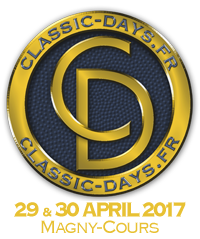| |
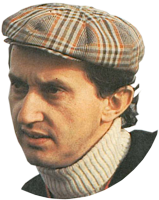
1934-1959:
BIRTH OF A PASSION
His childhood...
Renato MARTINI, later nicknamed "Tico" by English people, was born in December 6, 1934 in Pigna, Italy. Forced to exile with his family after the Second World War, Tico spends his childhood in Jersey.
At the age of 17, he passed his drinving licence and his father, headwaiter in a hotel, offered him his old car, a Landcaster.
It is the birth of a passion for the mechanics and cars.
His first experiences as a pilot...
This island being on the Britain regime, each nationality is affected to a specific sector of activity. Thus, Italian people had the authorization to work only in the hotel sector.
However, Tico wants to satiate his passion and comes back to Italy, in San Remo, with his parent's approval, in 1952. He starts working for a Alfa Romeo franchise holder.
In 1955, his father wants him to come back in Jersey to work in the hotel sector until the liberalization of the regulations. Tico does not wait for rules abrogation to become a member of the local Automobile Club. In 1957, he is enrolled for his first car race on the sand with his Cooper F3 bough the previous year. Despite an impressive dual with Bill Knigh, the favourite, Tico do not manage to win.
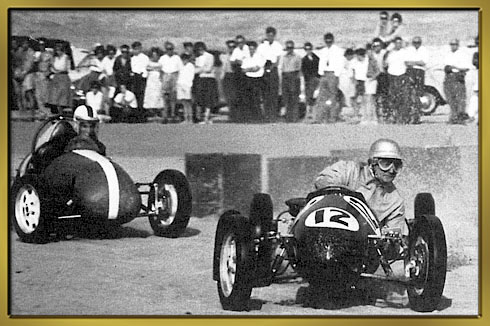 |
| The Martini/Knight dual |
In 1959, immigration laws are liberalized and Tico become manager of the mechanics workshop of a karting circuit owned by his new friend Bill Knight.
1960-1966:
TICO PILOT-INSTRUCTOR
The notoriety ...
In 1960, Tico Martini builds his own kart and becomes the Channel islands champion.
After having raced with his Cooper F3 on a mini kart circuit, he decides to "build a little but powerful car having all the avantages of the Cooper rolling straight and those of a kart when turning.
Thus, the first « Martini » was born, built with a moto Triumph engine and with scooter tyres. This hybrid car enables Tico to win, at Easter and in July 1961, the hill climb of Bouley Bay. |
|
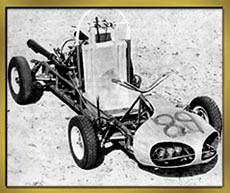 |
The little Tico Martini's hybrid car, 1961 > |
|
Singled out thanks to his performances, Tico is invited by David Good and Arthur Owen to race in England where he will be succesful. Thus, The Royal Automobile Club change his regulation and prevent Tico Martini's little car to race in hill climb.
The Winfield School ...
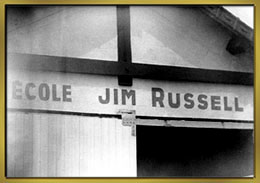 |
|
In 1963, Jean Bernigaud and the Sport-Auto review manage to make the Jim-Russell course come in Magny-Cours with the aim to develop a spring of young and talented pilots on the circuit. Bill Knight buies the name and the right of this course and finance it. |
| The Jim-Russell school, 1963 |
|
|
He nominates Henry Morrogh as director, and proposes to Tico to take care of the single-seaters, the Lotus 18. His first impressions are mixed: "a real circuit for cars, (...) authentic racing cars, but in the middle of nowhere".
Nevertheless he agrees. Living in a caravan during two years, Tico lives practically only for cars, receives pilot lessons by Henry Morrogh and becomes dribs and drabs instructor. |
|
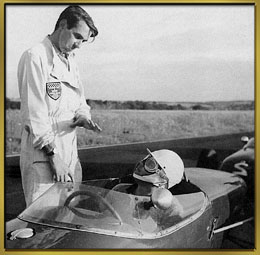 |
Henry Morrogh gives his last instructions > |
He ties solid friendly relations with his students, especiallly with Johnny Servoz-Gavin who defines Tico like « a character having a mid-Italian, mid-English mentality, rather shy, calm and understanding never using his authority and violence. "A human being with a pure mind not corrupted and entirely devoted to his passion".
After the departure of Henry Morrogh to the United States and the changing of corporate name of the school (now renamed "Winfield School" from the name of Bill Knight's English company "Winfield Motor Racing School Limited »), Tico becomes school director, administratively and technically.
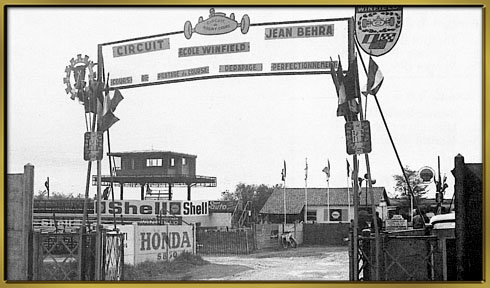 |
| The Winfied School |
He keeps racing but still remaining amateur, no question for him to become a professional pilot. He first drives a Lotus 23 Sport and then buies in 1967 a Brabham F3. Between the beginning of the season and july 1967, he drives during seven races but has to give up then for financial reasons.
During this period, Jean-Pierre Jaussaud, Jacques Weber, Claude Vigreux and François Cevert, win the Volant Shell, set up from 1963 and rewarding the best students of the Winfield School.
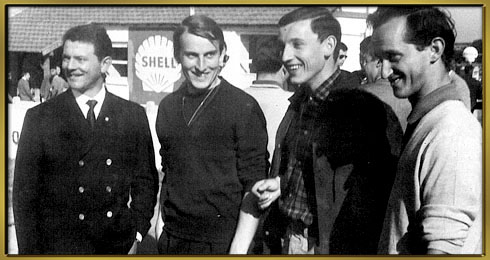 |
| Volant Shell winners (1963 à 1965) |
In 1966, Bill Knight decides to quit the business and gives the shares of his school to his two sons Mike and Richard and to his friend Tico.
1967-1972:
TICO MARTINI MANUFACTURER
The solution...
The financial problems also reach the school. Cars are too fragile and the spare parts are too expensive. Thus, Tico proposes to his two partners, Mike and Richard, to realise himself the single-seaters dedicated to the the school. Both brothers agree and in 1967, the first MW1 (Martini Winfield) was born. The car looked very much like a Brabham F3 and was dedicated to the pilot school. "I absolutely couldn't afford to fail, says Tico, otherwise this Martini would have been the first and the last one".
 |
| The MW1, 1967 |
Formula 3...
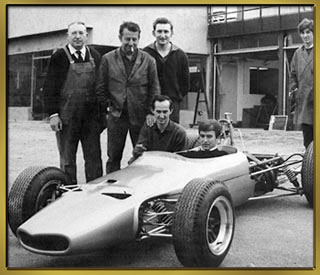 |
|
This same year, Automobile Martin builds the MW 1B that starts in May 1, 1968, in Formula 3, with 'Etienne Vigoureux. |
< The first Tico Martini's F3
with Etienne Vigoureux
(avril 1968) |
The quality of his cars enables Tico Martini to win the Challenge XAS 1969, that rewards the manufacturers and to reinforce the school notoriety. This year, José Dolhem, more famous because he was Didier Pironi's cousin, obtains the Volant Shell. The Jacques Laffite's MW3 F3 will be the last MW, since the MK4 (Martini Knight) will start to be produced in 1970.
From 1970, 26 single-seaters leave the Magny-Cours' workshops and good results follow one after the other for Jacques Laffite with two victories and a fifth place at the Formule France Championship.
The Formula Renault B.P. Racing team...
In 1972, the B.P. petrol company creates the Formula Renault B.P. Racing team and signs Jacques Laffite and Jean-Pierre Paoli. Under the yellow and green colors Jacques Laffite wins the championship with a MK 8.
Regarding Paoli, Tico says: « I was surprised by his speed and his feeling when attacking during the race". (...) But his qualities were not limited to the sport field, because, with time, I realised that his presence played a very important role in his manufacturer career".
A real friendship was born between these two men.
Paoli says:
«I've got a real admiration for him because the manufacturer's role is ungrateful.(...)
The manufacturing of a single-seater is a hard and difficult operation to break-even. Only a huge passion justifies such a choice. »
After the BP team creation, Tico becomes professional and proposes to Jacques Laffite to become Martini's test pilot. For Tico, the 1973 season balance is very positive: eight victories for Laffite, including the French Champion title, Paoli's victory on La Châtre circuit and 38 cars manufactured in Magny-Cours. In addition of this, Volant Shell titles keep to follow one another at the Winfied school : Guy Dhotel (1970), Bernard Beguin (1971), René Arnoux (1972) and finally Patrick Langlois (1973).
It is time to start talking about Formula 2...
1973-1977:
THE FORMULA 2 CONQUEST
Difficult beginnings...
After numerous hesitations, due to financial constraints, but also numerous solicitations, Tico Martini goes into Formula 2. In 1973, appeares the MK 23, with the hull and the body's mold created by english craftsmen. Unfortunately, the manufacturing takes too long time and the car cannot be enrolled to the 1973 championship.
Furthermore, this same year, the Messmer government intents to ban car sport competitions because of petrol's too expensive prices provoked by the petrol crisis. Fortunately, the FFSA president, Claude Bourillot, manages to make this decree taken off right after. The French car sport is in full strom. Martini's orders are canceled, the production is stopped and Formulas 2 delayed.
But in the same time,
The MK 14 knows a real monopole thaks to Didier Pironi : he wins the Formula Renault French champion title, and in 1976 the Formula Renault Euopean champion title. |
|
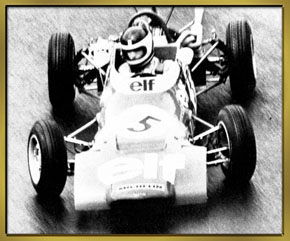 |
| MK 14, 1974 > |
The meeting between Martini and Pironi started in1964, when Didier's cousin, José Dolhem was Tico's student at the Winfield school. Pironi remenbers Tico : « I was blissfully happy. I saw him again during each José's internship, and we got acquainted. I really loved to hear him speaking ; (...) Tico owned a language so clear that every difficulty of the vocabulary disapeared. (...). »
« To conclude, Tico represented for me the sorcerer, from whom the speech is Gospel. »
The recognition ...
At the end of the 1973 season, the F2 starts again. After the study of the MK 23 structures, and Jacques Laffite's experience owned during the 73 season with a March, Tico builds his first hull, the MK16. It is a real evolution, Tico gives up the tubular structure to work on the hull he consider more effective " for the pilots' safety".
Then, Tico starts a partnership with Hughes de Chaunac's team, Oreca. Both men are very good firend and share a comon goal : to get closer of the english teams,, McLaren or Tyrrell.
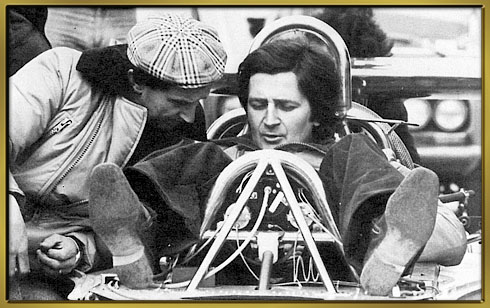 |
| Tico Martini and Hughes de Chaunac, two friends |
From his first race in Estoril (Portugal), start point of the 1975 season, the MK 16 already marks his territory with a victory thanks to Jacques Laffite.
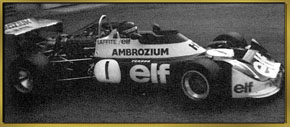 |
|
Nurburgring (Germany), Pau, Enna (Italy), these victory enable Jacques Laffite to become F2 European Champion.. |
< Jacques Laffite, F2 European Champion, 1975 |
| |
|
|
The 1975 season was thus the year of consecration for Jacques Laffite as pilot and for Tico Martini as manufacturer. Tico's brand image increases, reinforced by Martini's monopole in Formula Renault and Renault Europe. |
|
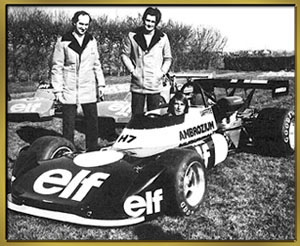 |
| Tico Martini, Hughes de Chaunac et Jacques Laffite, a winning team > |
Regarding the Winfield school, it is Yves le Strat, former R8 Gordini Cup pilot, who obtains the first Elf Pilot title, new Volant Shell's name due to a sponsor change. Followed then by Frédéric Watelet in 1975 and Jean-Claude Perrin in 1976.
The 1977 season...
In 1976, changes are made in the Martini/Elf team. Jacques Laffite leaves Martini and jumps into Formula 1, driving the first Ligier F1. Thus, the team signs two young pilots: Patrick Tambay (Volant Elf 1972 at Paul Ricard),
|
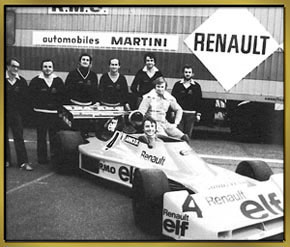 |
|
and René Arnoux (Volant Shell 1972 at Magny-Cours), young pilot promoted from Formule Renault Europe, called « Roy René » by the journalists at the end of the 1975 season. |
< René Arnoux et Didier Pironi, two Martini's expectancies. |
Patrick Tambay is thus impressed by Tico's methods of work: « We can discuss of everything and his great quality is to proceed to a summarization of every data to obtain a clear and sane conclusion. (...) In every situation he is still up, the two feet flat on the ground ».
During the 1976 season, Tambay drives a MK 19, whereas Arnoux gets back Laffite's MK16, from which the engine was modified in V6. Results are not there.
The 1977 year is marked by a high note for the Martini with a European champion title for René Arnoux driving a MK 22, lighter than a MK 16/V6 and owning a roll bar, real inovation in the car sport.
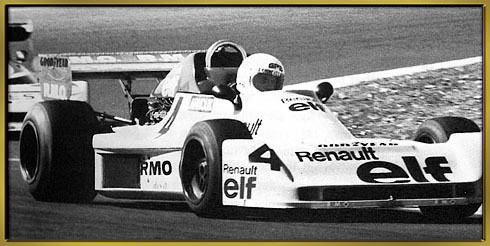 |
| René Arnoux ,F2 European Champion in 1977, drinving a MK 22 |
Tico, stayed in Magny-Cours to award Alain Ferté, 4th Elf Pilot, got aware of the victory by radio.
1978-1984:
THE F1 ADVENTURE AND THE COME BACK TO F3
The origins of the Formula 1 adventure...
For Tico Martini and Hughes De Chaunac, F1 means before everything the consecration of their activities in car sport. « With Tico, from several years, we gathered many things, men and structures that enable us to get onto this in a rather confident way ». This will to get into the F1 experience is also reinforced by the MK 16 success, followed by the MK 19 and MK 22 ones.
The Automobiles Martini company, thus established on a 250m² area at the Magny-Cours circuit's entrance, is moved in the industrial estate of the town that border the Moulins-Nevers road, on an area of 840m2. The new buildings are organised in three parts: an office for administration and studies, a spare parts shop and an engineering works. The new study team is composed of an engineer, a drawer and of course Tico.
The « Martinist » strategy and the Formula 1...
Tico Martini keeps the same manufacturing brand : a homogenity in the drawing, a very sober aesthetic without embellishment and a high level of finishing.
Thus appear the MK 23, equiped with a V8 Cosworth and drove by René Arnoux, Tico's favourite pilot. |
|
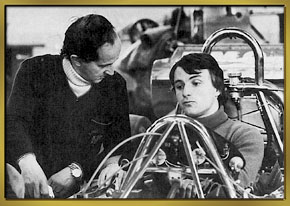 |
| René Arnoux and Tico Martini > |
The Team asks funds to RMO Temporary Work that finally decides to accept because:
« Tico and René symbolize [their] brand image:
seriousness, professionalism, modesty, kindness,
everything covered by a little bit of mystery.
They are in reality two representatives of anti-stardom. »
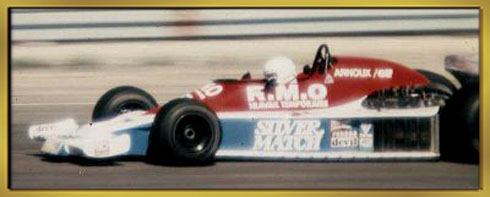 |
René Arnoux driving the MK 23
Source : http://ptritten.club.fr/fra78.htm |
A real "Martinist" strategy starts: two cars on the competition spot with a pilot, a single-seater car ready on the next circuit and a car at the workshop for the technical evolution and the research.
Unfortunately, Arnoux fails at the qualifications in South Africa, in Monaco, in Paul Ricard and also in Zolder. He only manages to get the 9th place in Belgium and in Austria.
Furthermore, the financial possibilities and the sponsorship are too weak. Tico's wisdom lead him to stop F1 and get back to the Winfield pilot school after six GP.
The come back to F3 : titles, titles, always titles...
The successes of « Martini-manufacturer » keep accumulating years after years. Several victories in F3 have to be added to the price list of the Automobiles Martini company: |
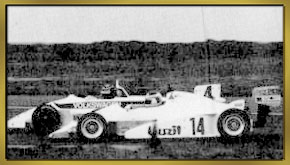 |
|
French champion titles with Pierre-Henri Raphanel in 1985 |
< Pierre-Henri Raphanel, F3 French Champion in 1985 with a MK 45 |
| |
|
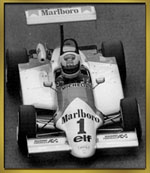 |
| and Yannick Dalmas the next year. |
|
| Yannick Dalmas, F3 French Champion in 1986 driving a MK 4 > |
| Or again a title of German champion won by Volker Weidler in 1985. |
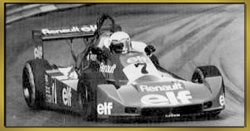 |
|
Finally, do not forget the two European champion titles obtained by Alain Prost in 1979 in MK 27 and Ivan Capelli five years later with a MK 42. |
| |
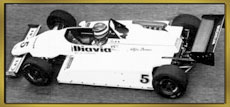 |
| Alain Prost F3 European Champion |
|
Ivan Capelli, F3 European Champion,
1984 > |
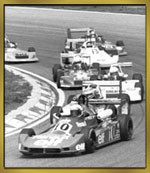 |
|
Alain Prost allowed to get the brand dynamic, especially thanks to numerous victories :
seven in eleven races with a MK 27,
mythical! |
| Alain Prost's MK 27 |
|
|
The come back to F2 is only realised in 1983, with since 1984 the French champion title and a third place at the European championship for Michel Ferté.
Despite this involvement in Formula 1 and those successes in Formule 3, the Winfield school did not stop to exist and kept rewarding with the Elf pilot title, Alain Neyrial in 1978, Patrick Saulnier, Dominique Dupuy, Jean-Luc Palis, Christophe Tinseau, David Tussau and many other pilots the following years.
2004 TO TODAY:
MARTINI-LIGIER CONNECTION
Martini-Ligier association...
At the beginning of 2004, Guy Ligier bought a significant part of shares in the Automobiles Martini company, to end with and official association with Tico Martini. « I want to end my life happy in what I love. Cars!(...) So, I went and saw Tico Martini and proposed him an association. »
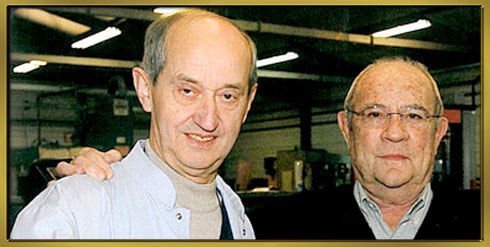 |
Tico Martini and Guy Ligier, a new association
source : Auto Hebdo, n°1635 (February 13, 2008) |
Guy Ligier is a former professional pilot, creator of the Ligier Team with which he leaded to victory famous pilots such as Jacques Laffite and Olivier Panis.
Thus, the two entities, blazon of the French car sport decided to join for a copmon goal. Their first "baby" was a Ligier MK 84, a competition car prepared for sports initiation and presented at the public during the world car meeting 2004.
Then, appeared the JS 47 alloted to the Formula 3 Championships since the 2005 season. Finally, the last one, a JS 49 that combine performances but also pleasure to drive. This car of 535kg, equiped with a Honda engine and piloted by Jonathan Cochet, drove for the first time in October 28, 2005 during the 4 000 km of Nevers-Magny-Cours.
Today, Tico Martini is still working in his workshop under Guy Ligier's direction.
He seems to have a second passion: aerial sport...
Thus, he already manufactured a microlight with which he flies over the landscape and he thinks about building another one.
Wait and see! |
|
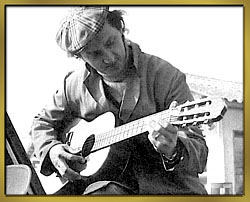 |
| Tico Martini > |
Source and acknowledgment :
Jean-Louis BALLERET (1993) Magny-Cours 30 ans de courses ! , S.I.N. PHOBOS
Edition
Patrick CAMUS (1953) Tico Martini : Artisan Constructeur,
SOLAR Edition
|
